Hops in Beer Brewing: Golden Star
Published: October 16, 2025 at 7:11:33 PM UTC
Golden Star is a Japanese aroma hop, known by the international code GST. Developed by Dr. Y. Mori at Sapporo Brewery in the late 1960s or early 1970s, it's a mutant selection of Shinshuwase. This lineage traces back to Saaz and Whitebine through open pollination. This heritage places Golden Star among Japanese aroma hops, valued for their fragrance rather than bittering power.
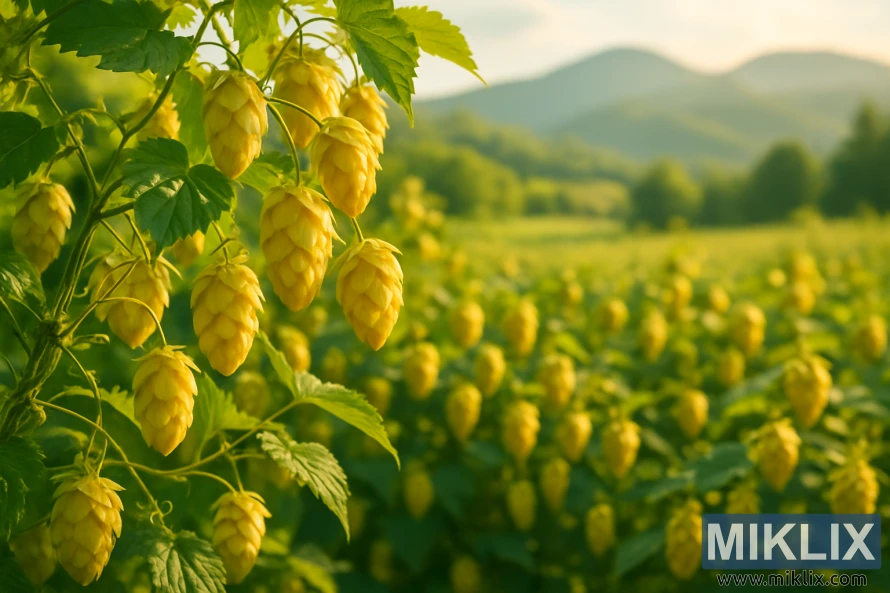
With a low alpha acid of roughly 4%, Golden Star is used mainly for its scent and flavor. Many brewers allocate about 62% of the hop bill to Golden Star. This makes the Golden Star hop profile crucial for craft brewers and commercial producers aiming for aroma-driven beers.
Though commercially grown only in Japan, Golden Star is available internationally. Availability and price vary by supplier, harvest year, and lot size. In the United States, brewers often source it through specialty distributors or larger platforms like Amazon. Listings reflect what buyers can expect when searching for Golden Star brewing material.
Key Takeaways
- Golden Star is a Japanese aroma hop, international code GST, bred at Sapporo Brewery.
- It has a low alpha acid (~4%), emphasizing aroma over bitterness.
- Golden Star hop profile often dominates a recipe's hop bill to deliver scent.
- Commercial cultivation is limited to Japan; international purchase depends on distributors.
- Available from multiple suppliers with price and supply varying by harvest year.
Origin and genealogy of Golden Star hops
The journey of Golden Star hops began in Japan during the late 1960s and early 1970s. At Sapporo Brewery, breeders aimed to enhance yield and disease resistance for local farmers. Their efforts were part of a broader push to improve hop cultivation.
Dr. Y. Mori of Sapporo Brewery is credited with selecting Golden Star from open pollination stock. The variety's lineage is often noted as Saaz × Whitebine, a common cross in Japanese hop breeding.
Some accounts suggest Golden Star is linked to Shinshuwase, showing superior yield and mildew resistance. This aligns with the Japanese hop breeding focus on robust, low-alpha aroma varieties.
There's a hint that Golden Star might be the same as Sunbeam, though this is not confirmed. The ambiguity stems from the use of open pollination and local names, blurring the lines among Sapporo Brewery's hop varieties.
- Parentage: Saaz × Whitebine via open pollination
- Breeder: Dr. Y. Mori, Sapporo Brewery
- Era of selection: late 1960s–early 1970s
- Breeding goals: increased yield and mildew resistance
Golden Star's lineage underscores a significant chapter in Japanese hop breeding. It highlights a focus on aroma quality and adapting to local growing conditions.
Aroma and flavor profile of Golden Star hops
Golden Star is an aroma hop celebrated for its late-boil and dry hopping uses. It's valued for enhancing the hop flavor profile with minimal bitterness. Its low alpha acids make it perfect for achieving scent and taste without IBUs.
The oil content of Golden Star averages near 0.63 mL/100g, with myrcene dominating at about 57% of total oil. This high-myrcene fraction contributes resinous, citrus, and fruit notes, enhancing the overall character. Humulene, at roughly 13%, adds woody and noble spice tones.
Caryophyllene, near 5%, brings peppery and herbal accents, positioning Golden Star as a spicy hop. The blend of these components creates a complex aroma. It balances floral and herbal elements with subtle citrus and resin.
As a floral hop, Golden Star can offer a soft, perfumed character in whirlpool or dry-hop applications. When used in late additions, it reveals more herbal and resinous facets. In blends, its aroma often takes the lead among Japanese aroma hops, adding distinctive top notes without heavy bitterness.
To achieve consistent hop flavor profile results, treat Golden Star like other aroma varieties. Focus on late additions, cool whirlpool times, and generous dry-hop schedules. These methods help preserve the delicate oils that define its floral, spicy, and citrus-resin personality.
Brewing values and chemical composition
Golden Star alpha acid averages near 5.4% in many reports. Yet, some datasets show a low-alpha range from about 2.1% to 5.3% depending on crop year. This variability means brewers should check batch certificates when formulating bitterness. They must adjust additions if targeting a specific IBU level.
Golden Star beta acid sits around 4.6% on average. Beta acids contribute to dry-hop and aging character more than boil bitterness. Brewers who rely on late additions will find the balance between alpha and beta acids useful. This balance is key for lingering bitter tones and hop-derived complexity.
The co-humulone percentage of Golden Star is roughly 50% of the alpha fraction. A higher co-humulone percentage can shift perceived bitterness toward a drier, sharper edge when used at high rates for early boil bittering. For gentle bitterness, favor later additions or blend with lower co-humulone varieties.
Hop Storage Index measurements place Golden Star near 0.36, which implies fair storability under typical conditions. A Hop Storage Index at this level suggests hops retain about 64% of original alpha potency after six months at 68°F (20°C). Fresh handling and cold storage will preserve volatile components better.
Reported hop oil content averages about 0.6–0.63 mL/100g. The oil profile shows high myrcene at roughly 57%, humulene near 13%, and caryophyllene around 5%. This composition favors bright, herbal, and floral aromatics when added late or used in dry hopping.
- Low-to-moderate Golden Star alpha acid makes the variety suited for flavor and aroma work rather than primary bittering.
- Golden Star beta acid and the oil profile reward late kettle additions and dry-hop schedules to capture volatile myrcene character.
- Monitor Hop Storage Index and store cold to protect hop oil content and maintain predictable performance.
In practice, pair small bittering charges with larger late-addition and dry-hop doses. This exploits aromatic richness while avoiding overly sharp bitterness from the co-humulone percentage. Adjust recipes to the tested alpha and beta values on the lot analysis for consistent results.
Growing characteristics and agronomy
Golden Star is grown commercially only in Japan, where every farming choice is influenced by Japanese hop agronomy. Growers plan for late seasonal maturity. They schedule plantings to match shorter growing windows in northern prefectures.
Reported Golden Star hop yield ranges from about 1,790 to 2,240 kg per hectare. This translates to roughly 1,600 to 2,000 lbs per acre. Such yield reflects a very good growth rate, provided vines receive proper support, nutrition, and irrigation.
Downy mildew resistance is a notable feature for this variety. Fields show improved mildew resistance compared with Shinshuwase. This reduces chemical spray frequency and labor for disease control.
- Hop harvest traits include a high sensitivity to cone shatter. Cones can break apart easily, which is more pronounced when plants are seeded.
- Shattering sensitivity affects the choice of harvest method. Mechanical harvesters may increase cone loss unless settings and timing are carefully adjusted.
- Late maturity requires planning for cooler autumns and potential rain around harvest. Timely picking reduces quality loss from weather exposure.
Post-harvest handling must prioritize gentle processing and rapid cooling. This limits shatter and preserves alpha acids. Golden Star retains about 64% of alpha acid after six months at 20°C (68°F). This gives moderate storage resilience if drying and packaging are done well.
Agronomy notes for U.S. growers or researchers studying the variety should emphasize localized trials. Trial plots help determine how Japanese hop agronomy practices translate to different soils and microclimates. They track Golden Star hop yield and hop harvest traits under local conditions.
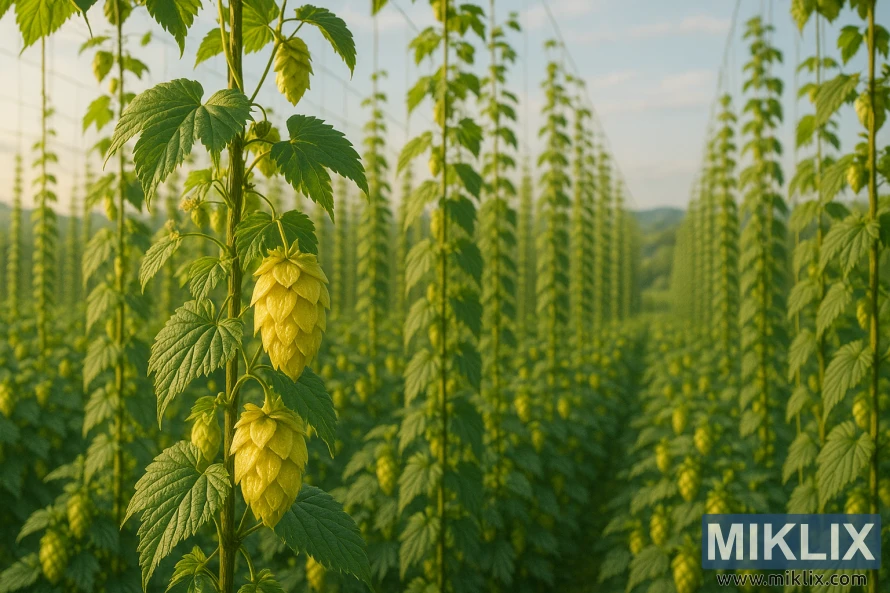
How Golden Star hops perform in beer styles
Golden Star shines as an aroma hop. It's best added late in the boil, in the whirlpool at low temperatures, or as a finishing hop. This method preserves its delicate floral, woody, and spicy oils, defining its unique character.
Recipes that heavily feature Golden Star allow it to dominate the beer's scent and flavor. This is without the need for high bittering potential. It's perfect for aroma-forward beers where hop character is paramount.
It pairs well with pale ales, session ales, amber ales, and lighter Japanese-style lagers. These styles benefit from a hop that enhances scent over bittering. Brewers seeking soft, layered aromatics often choose Golden Star for this purpose.
- Use 60–70% of total hop additions as late and dry-hop additions to highlight aroma.
- Add Golden Star in the whirlpool below 180°F to retain volatile oils.
- Favor dry hopping with Golden Star to lift floral and spicy notes without boosting bitterness.
Don't rely solely on Golden Star for bitterness. Its low-to-moderate alpha acids and variable co-humulone can lead to unpredictable bitterness. Pair it with a stable bittering hop like Magnum or Warrior for consistent IBUs.
In conclusion, Golden Star in ales and other aroma-forward beers offers brewers a distinct, aromatic profile. Employ it for finishing additions, measured whirlpool hops, and dry hopping. This approach maximizes volatile oil contribution while maintaining balance.
Substitutes and pairing hops
When Golden Star is hard to find, many brewers suggest Fuggle as a good substitute. Fuggle has a woody, mild spice and floral base similar to Golden Star. It's best to choose whole-leaf or pellet formats from reputable suppliers to preserve aroma.
Match the total oil emphasis on myrcene and humulene to balance bitterness and scent. East Kent Goldings are a good swap for English-style ales. For a more herbal or noble character, Saaz or Hallertau can be used in recipes needing a cleaner backbone.
Pair hops to enhance complexity without overpowering Golden Star's flavor. Combine it with citrus-forward hops like Citra or Amarillo for a bright, tropical flavor. For resinous depth, add Simcoe or Chinook in small amounts. Use Magnum or Challenger for neutral bittering to keep aroma hop pairings prominent.
Consider timing and form when substituting. Late additions and dry hopping preserve delicate floral notes. Since cryo or lupulin concentrates are not available for Golden Star, adjust hop weight and contact time to match aroma intensity.
- Classic English blends: Fuggle + East Kent Goldings for traditional ales.
- Citrus lift: Golden Star substitutes with Citra or Amarillo for pale ales.
- Resinous boost: Add Simcoe or Chinook for IPAs needing backbone.
- Neutral bittering: Use Magnum or Challenger to let aroma hop pairings shine.
Test small batches when substituting to ensure aroma balance. Keep records of hop weights, boil times, and dry-hop days. This data helps refine future hop pairings and find the best Golden Star substitutes for each beer style.
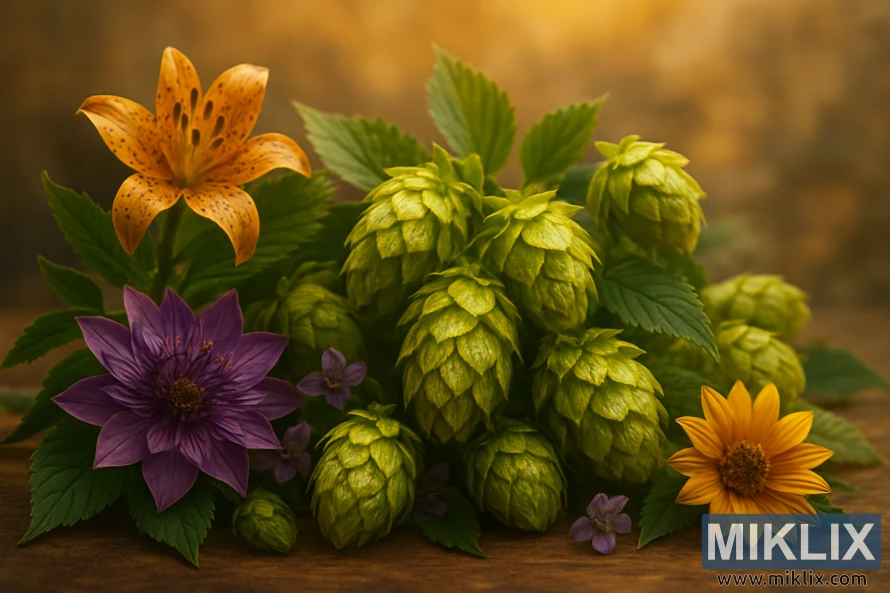
Usage techniques: getting the most aroma from Golden Star hops
Golden Star shines when kept from intense heat. Its oils are volatile, evaporating quickly with rising temperatures. Late hop additions protect these oils, enhancing floral and tropical notes.
Opt for flameout or short whirlpool rests at cooler temperatures. Techniques that maintain wort between 120–170°F ensure essential oils dissolve effectively. This method preserves hop aroma while avoiding harsh vegetal flavors.
Balance your brewing schedule with both late hop additions and a Golden Star dry hop. The high myrcene content benefits from post-boil additions. Dry hopping during or after fermentation captures fresh hop essence and complex aromas.
Handle whole-cone hops with care, as they can shatter and lead to losses. Pellet hops, on the other hand, are easier to manage and ideal for precise additions. They support the aromatic profile in recipes.
- Whirlpool techniques: cool quickly to target range, stir gently to suspend oils, avoid sustained high heat.
- Dry hop timing: active fermentation for biotransformation or post-ferment for clean aroma retention.
- Dosage: let Golden Star be the primary aromatic hop in single-hop recipes, reduce when blending with other assertive varieties.
Currently, there's no cryo or lupulin form available for Golden Star. This underscores the importance of handling choices. Proper management of contact time, temperature, and form is crucial for achieving optimal hop aroma in your beer.
Storage, freshness and hop handling best practices
Golden Star hop storage is crucial for maintaining aroma and bittering quality. The Hop Storage Index (HSI) for Golden Star is around 36% (0.36), indicating a fair rating. This means that after six months at 68°F (20°C), hops will retain about 64% of their alpha acids.
Keeping hops in cold storage helps preserve their freshness and volatile oils. Golden Star hops contain approximately 0.63 mL/100g of total oil. This makes aroma loss significant if the cones are exposed to warmth. It's essential to store them in a freezer or refrigerator, avoiding repeated warm-cold cycles.
Sealing hops in vacuum bags with a nitrogen flush minimizes oxygen exposure. This slows down oxidation, which reduces hop freshness and alpha acids. It's also beneficial to label the bags with the harvest and date to track their age.
Opt for pellets when feasible. Pellets are easier to dose, break less, and reduce mess. Whole cones, on the other hand, are prone to shattering. Handle them gently and wear gloves to avoid crushing the lupulin.
- Store frozen for long-term retention of alpha acids and oils.
- Refrigerate for short-term use within weeks.
- Use within months of harvest for peak aroma unless kept frozen.
Plan your inventory based on the Hop Storage Index and label bins with HSI Golden Star or similar metrics. Since commercial lupulin or cryogenic concentrates are not widely available for this variety, manage your whole-cone and pellet stock carefully.
When opening a bag, limit exposure time and re-seal quickly. For brew day, portion hops in small sealed packets to keep the rest fresh. These steps are essential for preserving hop freshness and maintaining the unique Golden Star character in your beer.
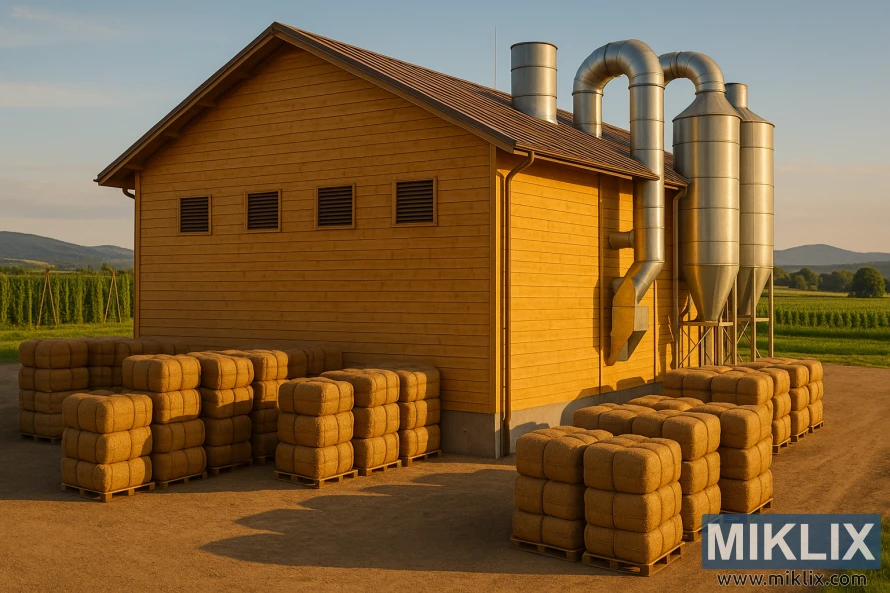
Commercial availability and where to buy Golden Star hops
Golden Star hops are available through specialty distributors and general retailers. You can find them at craft-focused hop merchants and larger online platforms like Amazon. Keep in mind that availability changes with each harvest season.
Due to its limited commercial cultivation in Japan, Golden Star hops are in short supply. They are often sold in small batches. Most international shipments are handled by importers and specialty hop distributors.
When reaching out to Golden Star hop suppliers, inquire about the harvest year and lab data on alpha and beta acids. It's important to know if the product is whole cone or pellet. Also, ask about packaging and cold-chain shipping to ensure freshness.
- Look for national hop directories to find licensed distributors that ship within the United States.
- Expect variable pricing and lot sizes depending on the harvest and carrier availability.
- No major lupulin cryo products currently exist for Golden Star, so plan recipes around whole cone or pellet forms.
For consistent supplies, plan ahead and establish accounts with multiple Golden Star hop suppliers. Small breweries and homebrewers can subscribe to mailing lists or join hop co-ops. This improves chances of securing Japanese hops for sale when new lots arrive.
Always request storage recommendations and verify return or replacement policies. Clear communication on origin, form, and testing is crucial. This helps reduce risks when buying Golden Star hops from overseas sources.
Comparisons with similar aroma hops
Brewers often compare aroma hops to choose the right match for a recipe. Golden Star vs Fuggle is a common pairing when an English-style alternative is needed. Fuggle brings earthy and woody notes, while Golden Star leans toward resinous citrus and fruity lifts.
Golden Star vs Shinshuwase appears in many technical notes. Golden Star originated as a mutant of Shinshuwase and shows higher yields and stronger mildew resistance. The two share a Japanese aroma lineage, yet sensory differences come from oil composition and concentration.
When you compare aroma hops across regions, focus on key oil fractions. Golden Star has a high myrcene fraction that gives resinous and citrus impressions. Humulene and caryophyllene add woody and spicy layers. English hops like Fuggle and East Kent Golding emphasize earth and mild florals instead.
- Practical substitution: use Fuggle if Golden Star is unavailable, but expect less citrus and resin in the final beer.
- Yield and agronomy: Golden Star outperforms Shinshuwase in field trials for harvest reliability and disease resistance.
- Brewing impact: small changes in late additions or dry hopping can shift the balance between resin, citrus, and woody notes.
To compare aroma hops in a recipe, trial small batches with identical grists and hopping schedules. Note the citrus/resin balance when testing Golden Star vs Fuggle and subtle variances in complexity when you compare Golden Star vs Shinshuwase.
Keep records of oil profiles, addition timing, and perceived aromatics. That practice helps you choose the best aroma hop for the style you want to achieve and clarifies how Golden Star compares to classic English varieties and its Shinshuwase parent.
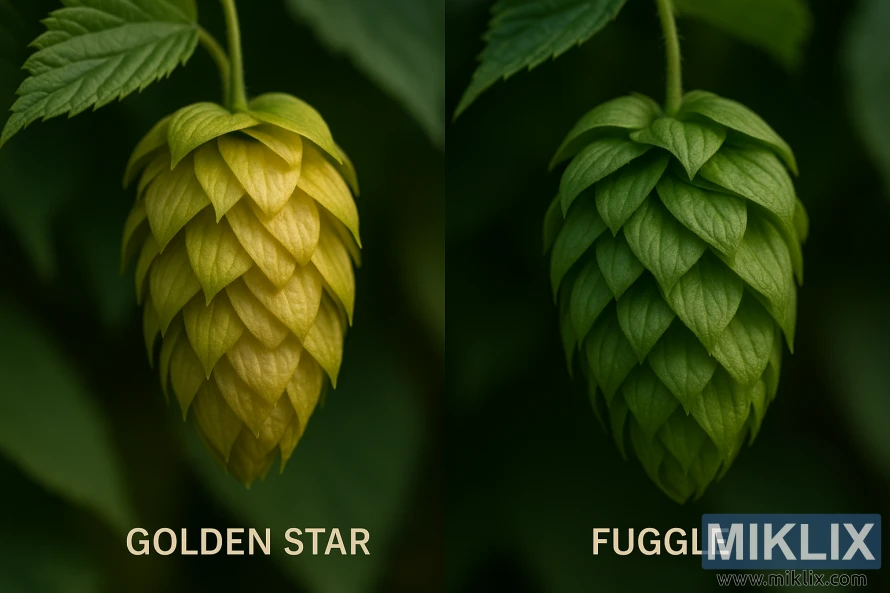
Practical recipes and sample brew schedules using Golden Star hops
Golden Star recipes shine when it's the main hop. Aim for 50–70% Golden Star in aroma-focused beers. It should be nearly 62% in beers where it's the star.
Adjust bittering based on the alpha acid content. The alpha acid range is about 2.1–5.3%, often around 4%. Use a neutral bittering hop or a small early addition of Golden Star to hit IBU targets without overwhelming the floral profile.
- Pale ale / Session ale: Use a neutral bittering hop for early additions. Reserve 50–70% of the hop bill as Golden Star split between flameout/whirlpool and dry hop. Typical dry hop dosing: 10–30 g per liter for intense aroma, scale to batch size.
- Japanese-style lager: Keep bittering minimal. Add Golden Star at whirlpool for delicate floral and woody notes. Add a light dry hop to lift aroma without clouding the lager body.
Follow a precise Golden Star brew schedule to capture volatile oils. For whirlpool, target 170–180°F (77–82°C) and steep for 15–30 minutes. This extracts aroma without excessive bitterness.
For dry hop with Golden Star, dry hop for 3–7 days. Place hops in secondary or add during late active fermentation to enhance integration and reduce oxygen pickup.
- Standard aroma timing: flameout or immediate whirlpool at 170–180°F, 15–30 minutes.
- Dry hop window: 3–7 days; consider pellets for consistent dosing because Golden Star cones can shatter.
- Dosage caveat: Modify amounts per supplier alpha test and target aroma intensity. Total oil near 0.63 mL/100g means modest weight yields good scent.
Keep batches small when testing Golden Star recipes. Run side-by-side trials with 50% and 70% Golden Star to compare impact. Use pellets for repeatability and adjust dry hop with Golden Star to taste.
Record gravity, IBU, and hop weights for each trial. A clear Golden Star brew schedule and measured recipes help scale results reliably for commercial or homebrew replication.
Regulatory, labeling and traceability considerations for hops
Brewers and importers must clearly list hop labeling details on product pages and invoices. Directory entries and supplier pages often include harvest year, alpha and beta acid lab data, and supplier provenance. These elements are crucial for audits and quality checks in breweries.
Importing Golden Star hops from Japan necessitates accurate country-of-origin statements and phytosanitary paperwork. U.S. importers must keep certificates and Customs filings that align with declared labels. This approach minimizes delays and ensures compliance with USDA and Customs regulations.
To maintain thorough hop traceability, record supplier batch and lot numbers for each delivery. Keep certificates of analysis showing alpha/beta acids and oil content for every lot. These documents enable brewers to correlate sensory results with specific raw material data.
Effective hop supply chain practices involve tracking storage temperature, humidity, and shipment conditions. Log chain-of-custody steps from farm to distributor. This preserves freshness and creates a defensible record in case of quality issues.
For food-safety and labeling, adhere to Alcohol and Tobacco Tax and Trade Bureau guidance when declaring hop origin on beer labels. Ensure consistent statements between ingredient records and finished-product claims to avoid regulatory inquiries.
Utilize digital tools for traceability to expedite recalls and supplier verification. Simple databases or QR-enabled lot tags can link COAs, harvest notes, and shipping logs. This enhances transparency across the hop supply chain while reducing manual errors.
When purchasing Golden Star hops, request up-to-date lab results and supplier provenance. Confirm that directory information and product pages align with physical paperwork. This habit ensures consistent batches and meets regulatory expectations.
Conclusion
Golden Star summary: This Japan-only aroma hop, developed by Sapporo Brewery and Dr. Y. Mori, is renowned for its floral, woody, spicy, citrus, and resin notes. Its oil content near 0.63 mL/100g and a myrcene-heavy profile (~57% myrcene) contribute to its bright top-end aroma. Moderate humulene and caryophyllene fractions add depth. Alpha acids are low to moderate (commonly cited around 4–5.4%), so controlling bitterness and hop schedule is crucial when brewing with it.
Golden Star hop takeaway: View this variety as an aroma specialist. Late kettle additions and dry hopping preserve its volatile terpenes, delivering the character brewers seek. Manage freshness carefully—reported HSI around 36% and co-humulone near 50% mean you should track harvest year and request a certificate of analysis from suppliers to maintain consistent results.
Best uses Golden Star are in styles that showcase delicate aromatics: pilsners, golden ales, saisons, and lighter IPAs where floral-citrus-resin balance complements malt. Commercial supply is largely Japan-based and import-dependent, with no cryo or lupulin concentrates available. When sourcing is tight, experienced brewers commonly turn to Fuggle as a practical substitute while noting the difference in specific terpene ratios.
Further Reading
If you enjoyed this post, you may also like these suggestions:
